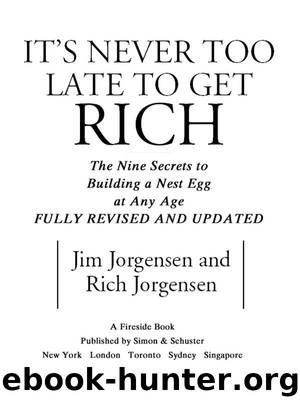It's Never Too Late to Get Rich by Jim Jorgensen & Rich Jorgensen

Author:Jim Jorgensen & Rich Jorgensen
Language: eng
Format: epub
Publisher: A Fireside Book
Published: 2003-07-15T00:00:00+00:00
Individually Managed Accounts
In the past wealthy investors who had upward of $500,000 could invest in separate managed accounts. Today, with computers and block trading, the minimum can be as low as $50,000. An individually managed account differs from a mutual fund in that the investors own the individual securities in their own account, rather than having an interest in an investment pooled mutual fund. Invested funds typically go into a brokerage account and the account is accessible at any time on the web or with monthly statements. Often the portfolio manager has discretionary authority within general guidelines. For instance, the investor could authorize the manager to invest in any of the Dow 30 stocks without discussing it first.
If at any time the investor needs cash, he or she can contact the brokerage firm and the cash can be quickly in their hands. Most individually managed accounts do not charge a load or a sales commission and there is no charge for withdrawals. Typically, there is an annual management fee paid monthly or quarterly.
Individually managed accounts offer several advantages over mutual funds. They generally provide better tax benefits, since investors are not subject to “phantom” capital gains as is possible in funds. They keep the risk level to the known securities in the account, and you don’t have to worry about fund investors bailing out and the fund manager selling huge blocks of stock.
Mutual funds have been notorious for not disclosing their current assets or not letting investors see exactly what the fund manager is doing. The best most investors can do is to check with one of the fund services like Morningstar and look at the fund’s top five holdings, which could be months old. With a managed account, the investor sees exactly which stocks are in his or her portfolio at any time.
This can be a bit nerve-racking if a portfolio manager is working diligently for performance. You never see all these behind-the-scenes activities in your mutual fund. The fund managers don’t want investors to see the rough-and-tumble daily maneuvering to enhance performance. There would be too many queries from shareholders. There are various techniques with which the investor may not be familiar. For instance, if the account is large, the manager may scale into a position, buy a few shares, then more later. There may be a period of choppiness where trends are not clear, and the manager may buy only to sell a short time later as trends reverse. The stock market is sometimes fickle.
A noted portfolio manager was once asked how he was able to buy near the exact lows, and he replied that observers didn’t always appreciate it was sometimes his fourth or fifth entry into the market, working hard to be in the uptrend if it was sustained, and preserve his clients’ capital if it was not.
Investment managers will often use limit orders. When an investor buys a stock with a market order, he is paying the price of the stock when the order is executed.
Download
This site does not store any files on its server. We only index and link to content provided by other sites. Please contact the content providers to delete copyright contents if any and email us, we'll remove relevant links or contents immediately.
| Budgeting & Money Management | College & Education Costs |
| Credit Ratings & Repair | Retirement Planning |
The Compound Effect by Darren Hardy(8808)
Tools of Titans by Timothy Ferriss(8215)
Nudge - Improving Decisions about Health, Wealth, and Happiness by Thaler Sunstein(7615)
Win Bigly by Scott Adams(7094)
Deep Work by Cal Newport(6877)
Rich Dad Poor Dad by Robert T. Kiyosaki(6399)
Pioneering Portfolio Management by David F. Swensen(6226)
Principles: Life and Work by Ray Dalio(6204)
The Barefoot Investor by Scott Pape(5698)
Digital Minimalism by Cal Newport;(5661)
Grit by Angela Duckworth(5512)
The Slight Edge by Jeff Olson(5346)
Discipline Equals Freedom by Jocko Willink(5281)
The Motivation Myth by Jeff Haden(5155)
You Are a Badass at Making Money by Jen Sincero(4866)
The Four Tendencies by Gretchen Rubin(4544)
Eat That Frog! by Brian Tracy(4431)
The Confidence Code by Katty Kay(4187)
Bullshit Jobs by David Graeber(4094)
